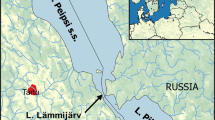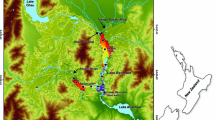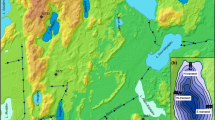Abstract
The water balance of Lake Naivasha, has been calculated from a model based upon the long-term meteorological data of rainfall, evaporation and river inflows. The lake is Kenya's second Ramsar site because of its international importance as a wetland, but supplies drinking water to Nakuru and irrigation water to the nationally important industries of horticulture and power generation. Groundwater flows into and out of the lake are estimated from the model's success in predicting water level fluctuations over the same period. The most accurate predictions of lake level were derived from the data sets of river discharges known to be from the most-reliable time period and gauging stations. The model estimated a current annual abstraction rate of 60 × 106 m3 ann−1, a figure perhaps six-times higher than that calculated as a `safe' yield in the 1980s. There is an urgent need to accurately measure all abstractions and provide consistent, reliable, hydrological and meteorological data from the catchment, so that a `safe' yield may be agreed upon by all stakeholders and sustainable use of the lake waters achieved.
Similar content being viewed by others
References
Anon, 1984. Lake Naivasha Studies. File WD/4/4/231, 23/10/84. Ministry of Water Development, Nairobi: 4 pp.
Anon, 1996. The Lake Naivasha Management Plan. Lake Naivasha Riparian Owners' Association, Naivasha, July 1996: 48 pp.
Anon 1997. A Proposal for the Implementation of the Lake Naivasha Management Plan. Lake Naivasha Riparian Owners' Association, Naivasha, April 1997: 19 pp.
Åse, L-E., Sernbo, K. & Syren, P., 1986. Studies of Lake Naivasha, Kenya and its Drainage Area. Forkningsrapporter 63, Stockholms Universitet Naturgeografiska Institutionen, Stockholm: 75 pp.
Ashton, P. J., 2002. Avoiding conflicts over Africa's water resources. Ambio 31: 231–235.
Brind, W. & J. Robertson, 1958. The Hydrology of Lake Naivasha. Hydrology Section, Ministry of Works, Nairobi: 9 pp.
Butzer, K. W., G. L. Isaac, J. L. Richardson, & C. Washbourne-Kamau, 1972. Radiocarbon dating of East African lake levels. Science 175: 1069–1076.
Clarke, M. C. G., D. G. Woodhall, D. Allen & G. Darling, 1990. Geological, Volcanic and Hydrological Controls on the Occurrence of Geothermal Activity in the area surrounding Lake Naivasha, Kenya. Minstry of Energy, Nairobi: 138 pp.
Enniskillen, 2002. The Lake Naivasha Management Plan–consensus-building to conserve an international gem. Hydrobiologia 488 (Dev. Hydrobiol. 168): ix–xii.
Gaudet, J. & J. M. Melack, 1981. Major ion chemistry in a tropical African lake basin. Freshwat. Biol. 11: 309–333.
Goldson, J. 1993. A Three Phase Environmental Impact Study of Recent Developments around Lake Naivasha. Lake Naivasha Riparian Owners' Association, Naivasha, December 1993: 109 pp.
Leakey, L. S. B., 1932. East African lakes. Geog. J. 77: 497–512.
Nilsson, E., 1932. Quarternary Glaciations and Pluvial lakes in British East Africa. PhD Thesis, Centraltryckeriet Stockholm: 101 pp.
Oestergaard, P., 1974. Abstraction of water from Lake Naivasha. Files WRH 206 vol IV/131, 5/4/74: 2 pp and WRH 206 vol III/132, 28/5/74: 5pp, Ministry of Water Development, Nairobi.
Richardson, J. L., 1966. Changes in the level of Lake Naivasha, Kenya, during postglacial times. Nature, 5620: 290–291.
Richardson, J. L. 1972. Palaeolimnological records from Rift lakes in central Kenya. In van Zinderen Bakker, E. M. (ed.), Palaeolimnology of Africa, the Surrounding Islands and Antarctica. Balkema, Cape Town: 131–136.
Richardson, J. L. & A. E. Richardson, 1972. History of an African Rift lake and its climatic implications. Ecol. Mongogr. 42: 499–534.
Sikes, H. L., 1936. Notes on the hydrology of Lake Naivasha. Journal of the East African and Uganda Natural History Society, 13: 73–89.
Stuttard, M., J. B. Hayball, G. Narciso, M. Suppo, L. Isavwa & A. Oroda 1999. Modelling lake level changes: examples from the Eastern Rift Valley, Kenya. In Harper, D. M. & A. Brown (eds), The Sustainable Management of Tropical Catchments. J. Wiley & Sons, Chichester: 337–358.
Tetley, A. E., 1948. Notes on Lake Naivasha by the Hydraulic Engineer. Directorate of Water Development, Nairobi: 9 pp.
Vincent, C. E., T. D. Davies & U. C. Beresford, 1979. Recent changes in the level of Lake Naivasha, Kenya, as an indicator of equatorial westerlies over East Africa. Climatic Change 2: 175–191.
Author information
Authors and Affiliations
Rights and permissions
About this article
Cite this article
Becht, R., Harper, D.M. Towards an understanding of human impact upon the hydrology of Lake Naivasha, Kenya. Hydrobiologia 488, 1–11 (2002). https://doi.org/10.1023/A:1023318007715
Issue Date:
DOI: https://doi.org/10.1023/A:1023318007715




